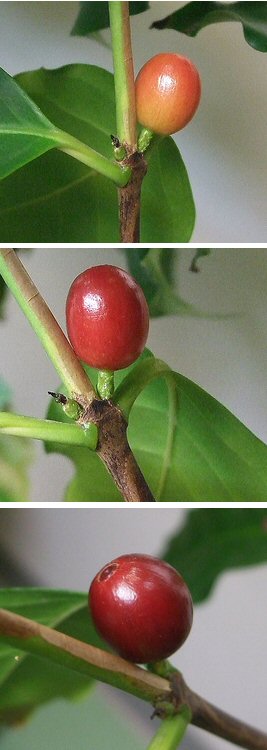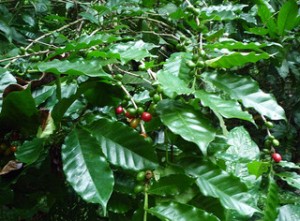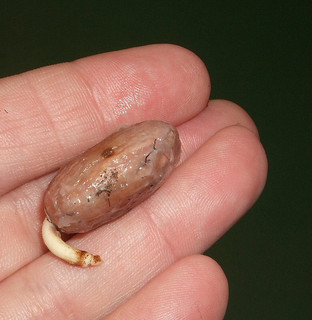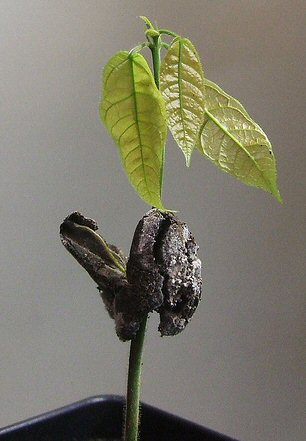Finally, ripe cherries!
This is my third post regarding my growing (literally) little coffee farm in southeast Michigan. My first post, Growing coffee at home, documented my initial attempts at germinating coffee beans I collected on a trip to Panama in January 2008, one of which flowered in April 2011. My second post, Update on Finca Dos Gatos, covered the bean development, transplanting, and other outdoor accommodations. Here is one more update.
 Panama plants
Panama plants
These were my original plants, which I grew from seed collected around Volcan, Panama. The chronology:
- Seeds harvested from ripe cherries in January 2008.
- Seeds germinated in May 2008.
- First flower buds: 12 April 2011, only on one plant.
- Flowers opened 25 May 2011.
- Two fruit begin to develop 15 July 2011.
- Fruit full size, but green September 2011.
- Fruit finally begins to ripen mid-February 2012.
- Fully ripe and harvested by mid-March.
The last interesting thing about this crop was that after I picked the cherries and removed the skin, I discovered that both contained peaberries instead of two flat beans. This occurs due to one of the ovules not developing, usually from lack of fertilization. Arabica coffee is self-pollinating, but perhaps this is to be expected when there are only two flowers! After the two beans dried, I noticed they are much less dense than a normal bean…nearly as light as a roasted bean. My first crop is just souvenirs.

Nicaragua plants
I have collected seeds twice from Nicaragua. My first batch was from Finca Esperanza Verde which I planted in March 2009. These germinated in June 2009, and now have their first flower buds. I have three plants and have given others away.
The second set was collected in March 2011 from El Jaguar and Selva Negra; they germinated in mid-May 2011. I’ve given away some seedlings and have chosen to keep just two plants: one from Selva Negra and one of the yellow catuai variety from El Jaguar.
In November, I performed an experiment where I provided a “dry season” for the Panama and first batch of Nicaraguan plants. I restricted water for a couple weeks, then stop watering for three weeks. Then, I watered like crazy, and began switching over the fertilizer from the Earth Juice ”Grow” to the Earth Juice “Bloom”. Further, I swapped out half the lights in the system to 3000K red spectrum bulbs instead of 6500K blue lights (Sun Blaze T5 in four-foot fluorescent fixtures).
And sure enough, I have a ton of flower buds, which began to develop in early February. Although the first time around, the buds developed quickly, in a month, so far all the buds I have are growing slowly, and have not yet opened.
Honduras – new additions
 In November 2011, I was in Honduras. This trip was not to coffee farms, as we were staying in a lowland area on the northern coast. However, there was coffee growing in the region, and I picked up cherry from a semi-tended plot owned by the Lodge at Pico Bonito that had both coffee and cacao, as well as some at Pico Bonito itself. Traditional old varieties of arabica coffee don’t grown at this altitude with the heat and humidity. I figured it must be some varietal that included robusta heritage, and Daniel Humphries identified it from photos as catimor, a hybrid between caturra and Hybrido de Timor (itself a naturally-occurring hybrid between arabica and robusta).
In November 2011, I was in Honduras. This trip was not to coffee farms, as we were staying in a lowland area on the northern coast. However, there was coffee growing in the region, and I picked up cherry from a semi-tended plot owned by the Lodge at Pico Bonito that had both coffee and cacao, as well as some at Pico Bonito itself. Traditional old varieties of arabica coffee don’t grown at this altitude with the heat and humidity. I figured it must be some varietal that included robusta heritage, and Daniel Humphries identified it from photos as catimor, a hybrid between caturra and Hybrido de Timor (itself a naturally-occurring hybrid between arabica and robusta).
In Honduras, two lines of catimor are common. One is IHCAFE 90, released in the 1990s and derived from the T5175 line out of Portugal or Brazil. The other is Lempira, from the T8667 line out of Brazil.
I had a bunch of it sprout by mid-January, and gave away some seedlings, saving a couple for myself.
Cacao
Okay, this is a coffee “finca” but I had to see if I could also grow some cacao, which was growing all over the place, including outside our cabin and next to the coffee. Here are some trees at Pico Bonito with their bizarre unripe pods.

These pods are tough and leathery and often have to be opened with a machete, but animals had opened some and we were able to retrieve the large seeds. I read that they must always be kept warm and moist, so I wrapped them in damp paper towels. No long wait like coffee. By the time I got home a few days later, they were beginning to sprout.

By early December, I had little plants about five inches tall.

In order to maintain a little more warmth and humidity, I constructed a little enclosure for the three cacao plants by wrapping overhead transparency plastic around a wire bird feeder squirrel-excluder. It sits on top of a cheap, twelve-inch plastic flower pot saucer. Another saucer went on top.

I look forward to bringing the finca outdoors for the summer, when I know everything will take off; the cacao should especially enjoy our hot, humid Michigan summer. Perhaps I’ll do one more update with photos of more of my coffee in flower, and any resulting crop.

 The Ovenbird (Seiurus aurocapillus) is often heard before it is seen, a loud ringing “tea-cher, TEA-cher, TEA-CHER!” broadcast from close to the forest floor through much of the
The Ovenbird (Seiurus aurocapillus) is often heard before it is seen, a loud ringing “tea-cher, TEA-cher, TEA-CHER!” broadcast from close to the forest floor through much of the  On their North American breeding grounds, Ovenbirds need large forests to breed in, and habitat loss and fragmentation has taken its toll. Even in large forests in northern regions, declines in reproductive success are tied to, believe it or not, earthworms.
On their North American breeding grounds, Ovenbirds need large forests to breed in, and habitat loss and fragmentation has taken its toll. Even in large forests in northern regions, declines in reproductive success are tied to, believe it or not, earthworms.





